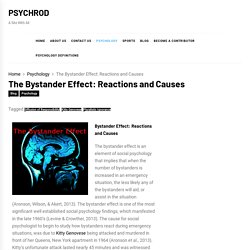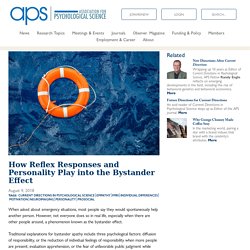

Bystander Effect - IResearchNet. Bystander Effect Definition Individuals who see or hear an emergency (but are otherwise uninvolved) are called bystanders.

The bystander effect describes the phenomenon in which such individuals are less likely to seek help or give assistance when others are present. This does not mean that bystanders are apathetic to the plight of others, for bystanders often show signs of distress, anxiety, and concern if they delay responding or fail to respond at all. It also does not necessarily mean that a victim will be less likely to receive help as the number of bystanders present increases—after all, the greater the number of other people present, the greater is the likelihood that at least one of them will intervene. The bystander effect - Economic and Social Research Council. The Bystander Effect. How The Murder Of Kitty Genovese Created The Bystander Effect.
Wikimedia CommonsKitty Genovese whose muder would inspire the psychological phenomenon known as the bystander effect.

At approximately 3:15 a.m. on March 13, 1964, a woman was murdered. Her name was Kitty Genovese. She was 28 years old, “self-assured beyond her years,” and had a “sunny disposition.” However, on that Friday evening, none of that mattered. As Kitty Genovese was stabbed to death in an alleyway outside her home, the friends and neighbors she had lived next to for several years stood by, choosing not to get involved as she lay there dying. Around 2:30 a.m. on the night of her attack, Kitty Genovese left the bar she worked at and headed for home. A few minutes after she left, she stopped at a traffic light. At 3:15, Genovese pulled into the parking lot of the Kew Gardens Long Island Rail Road station parking lot, which was about 100 feet from her front door. Getty ImagesKitty at work at Ev’s bar. Upon being stabbed, Genovese screamed, running toward her home.
A New Look at the Killing of Kitty Genovese: The Science of False Confessions – Association for Psychological Science – APS. On March 13, 1964 a woman named Catherine “Kitty” Genovese was murdered outside of her apartment in Queens, New York.

Over the course of a brutal attack lasting over 30 minutes, Genovese was stabbed at least 14 times. More than 50 years on, the murder of Kitty Genovese is still throwing up fresh psychological revelations. By Christian Jarrett The horrific killing of Catherine “Kitty” Genovese in New York in 1964 inspired research into what’s known in social psychology as the Bystander Phenomenon – our increased disinclination to intervene when in the company of others.

That’s because early reports told how 38 witnesses to Genovese’s murder did nothing to help. The Bystander Effect: Reactions and Causes - PSYCHROD. Bystander Effect: Reactions and Causes The bystander effect is an element of social psychology that implies that when the number of bystanders is increased in an emergency situation, the less likely any of the bystanders will aid, or assist in the situation (Aronson, Wilson, & Akert, 2013).

The bystander effect is one of the most significant well established social psychology findings, which manifested in the late 1960’s (Levine & Crowther, 2013). The cause for social psychologist to begin to study how bystanders react during emergency situations, was due to Kitty Genovese being attacked and murdered in front of her Queens, New York apartment in 1964 (Aronson et al., 2013). Kitty’s unfortunate attack lasted nearly 45 minutes and was witnessed by nearly 38 residents who did not assist by calling police, or trying to stop her attacker (Aronson et al., 2013). How Reflex Responses and Personality Play into the Bystander Effect – Association for Psychological Science – APS. When asked about emergency situations, most people say they would spontaneously help another person.

The 21st century bystander effect happens every day online. If you’re going to fall, injure yourself and need help, where is a good place to do it?

Should you choose a busy thoroughfare or a deserted backstreet? Overcoming the Bystander Effect — The RAD Group. Research and personal experience both demonstrate that people are less likely to intervene (offer help) when there are other people around than they are when they are the only person observing the incident.

This phenomenon has come to be known as the Bystander Effect and understanding it is crucial to increasing intervention into unsafe actions in the workplace. It came to light following an incident on March 13, 1964 when a young woman named Kitty Genovese was attacked by a knife-wielding rapist outside of her apartment complex in Queens, New York. Many people watched and listened from their windows for the 35 minutes that she attempted to escape while screaming that he was trying to kill her.
How to overcome the bystander effect. While most of us are sympathetic toward helping someone, the bystander effect can prevent us from stepping in.

The bystander effect is when a group of people sees a problem or someone in need, but no one does anything to help. Why don’t we help? One reason why people choose not to help is because they observe and follow what other people are doing. So if everyone is passing by and not paying attention, we conclude that what’s happening isn’t a big deal.
After all, no one else looks concerned. You’ve probably experienced a similar phenomenon in class. So what can you do? Another reason why people don’t help is because of the diffusion of responsibility. If you notice something like possible symptoms of alcohol poisoning, a couple fighting, or something else that just doesn’t feel right, don’t wait for someone else to step in – take action immediately. What can you do? How to reverse the Bystander Effect. You see a shopper trip over in a busy street.

Someone else can help. That’s what you tell your conscience. Overcoming the Bystander Effect. What Is the Bystander Effect? – Now. Powered by Northrop Grumman. The Bystander Effect: How to React If You See Someone Being Harassed. Sherrif Karamat, CAE, is President and Chief Executive Officer of PCMA. Karamat also serves as President of the PCMA Foundation and Publisher of Convene magazine. As CEO, Karamat leads the vision, mission and promise for PCMA’s global family of brands. Karamat serves the greater business events industry as a prominent business architect, enabling our community to become a catalyst for economic and social progress, organizational success, and personal and professional development.
In his previous role as Chief Operating Officer, Karamat led the development and implementation of PCMA’s new vision: driving global economic and social transformation through business events. In addition to his responsibilities at executive level, Karamat also directed streamlining of PCMA’s content creation and delivery channels into one organization. Karamat is a life-long learner.